Standing over four feet tall, the shoebill stork is one of the most awe-inspiring and unusual birds on Earth. With its massive, shoe-shaped bill, piercing yellow-green eyes, and towering stature, the bird looks almost prehistoric, as though it stepped out of a time long before humans existed. It is so extraordinary that many people, upon seeing images of it, assume it must be a mechanical creation or a cleverly designed prop. Yet, these incredible creatures are entirely real, inhabiting the tropical swamps and marshes of East Africa, where they have thrived for centuries despite the pressures of modern life.
Shoebills are not just unusual for their size. Their demeanor is equally remarkable. They can stand perfectly still for hours at a time, seemingly motionless, as they patiently wait for the right moment to catch prey. This stillness gives them a ghostly presence in the swamp — one that is both intimidating and mesmerizing. Locals who encounter these birds in the wild often describe them as statuesque, like living relics from an ancient era.
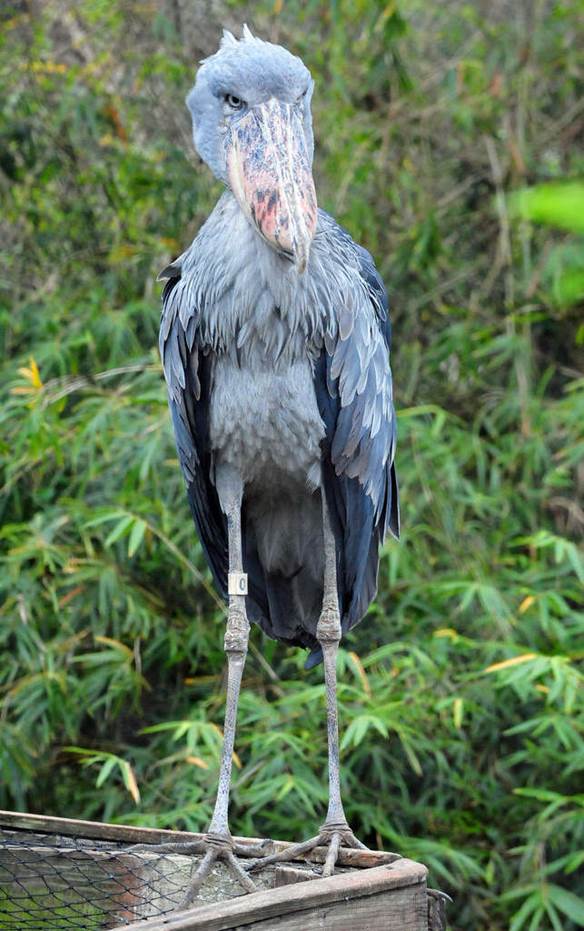
Anatomy and Prehistoric Features
The shoebill’s most notable feature is undoubtedly its enormous bill, which resembles a wooden shoe in shape. This massive tool is perfectly adapted for hunting, allowing the bird to catch large fish, frogs, and even young crocodiles. Its sharp edges can clamp down with surprising force, making the shoebill a formidable predator in its aquatic environment. The bird’s eyes are set forward on its head, giving it excellent binocular vision, crucial for spotting prey even through the dense marsh vegetation.
Standing tall and broad-shouldered, the shoebill can appear almost cartoonish, particularly when its head jerks forward and backward in quick bursts — a motion that makes it seem robotic. But this behavior is purposeful. The jerky movements help it gauge distance and precisely time its attacks. Despite its intimidating appearance, the shoebill is surprisingly patient. It often remains still for hours, conserving energy while waiting for an unsuspecting fish or reptile to come within reach.
Beyond its impressive hunting adaptations, the shoebill’s wingspan is equally breathtaking. These birds can stretch their wings to over eight feet, enabling them to fly short distances even though their size might suggest otherwise. When in flight, they glide silently above the swamp, an imposing silhouette against the horizon.
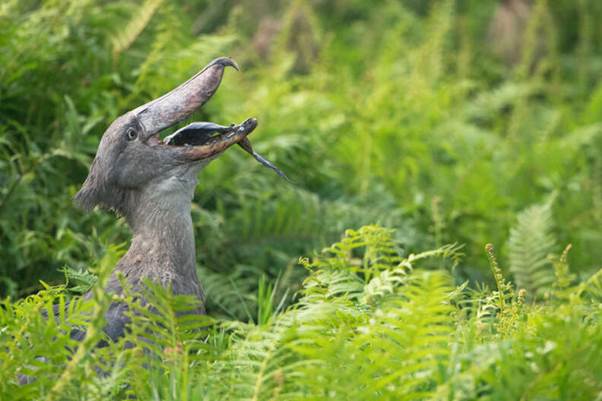
Diet and Hunting Behavior
Shoebills are apex predators in their habitat. While fish form the bulk of their diet, they are not limited to small prey. Reports from naturalists have documented shoebills hunting monitor lizards, frogs, and even baby crocodiles. Their approach to hunting is methodical. A shoebill will position itself at the edge of a marsh or shallow waterway and remain motionless, sometimes for hours, as it watches for movement below the surface. When prey is within striking distance, it attacks with lightning speed, using its enormous bill to seize its target before it has a chance to escape.
Interestingly, shoebills are largely silent birds. They only make noise in specific situations, such as clapping their bills together to greet another bird or to communicate with their young. This quiet nature complements their hunting strategy, allowing them to approach prey without startling it. Their imposing appearance alone — a creature four feet tall with a bill capable of snapping a small crocodile — is often enough to assert dominance in their territory.
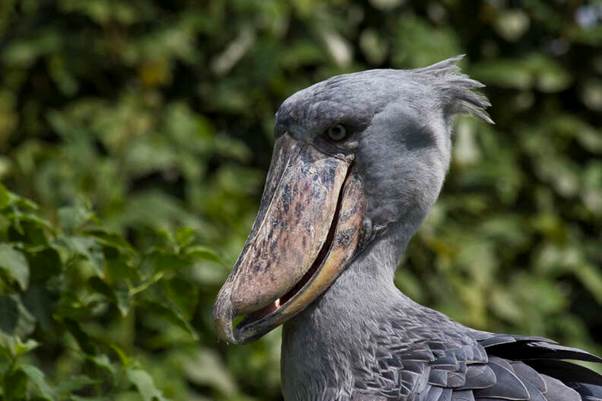
Conservation Challenges
Despite their impressive adaptations and enigmatic presence, shoebills face serious threats in the wild. Habitat destruction is perhaps the most significant risk. The marshlands of East Africa, particularly around Mambamba Lake, are under pressure from agriculture, oil exploration, and human settlement. These activities reduce the availability of suitable hunting grounds, forcing shoebills to adapt to increasingly fragmented environments.
In addition to habitat loss, shoebills are targeted by the illegal bird trade. Their striking appearance and rarity make them highly sought after by collectors, often leading to capture in the wild. Unfortunately, shoebills are extremely sensitive birds, and mortality rates during capture, transport, and captivity are alarmingly high. Captive breeding has proven largely unsuccessful, with only a handful of chicks ever hatched in zoos — two in 2008 and one in 2009. This inability to sustain captive populations means that poachers continue to rely on wild-caught birds, further endangering natural populations.
Researchers emphasize that protecting wild shoebills requires vigilant conservation measures and strict enforcement against illegal trade. Without these protections, one of the most remarkable bird species in the world could face continued population decline.
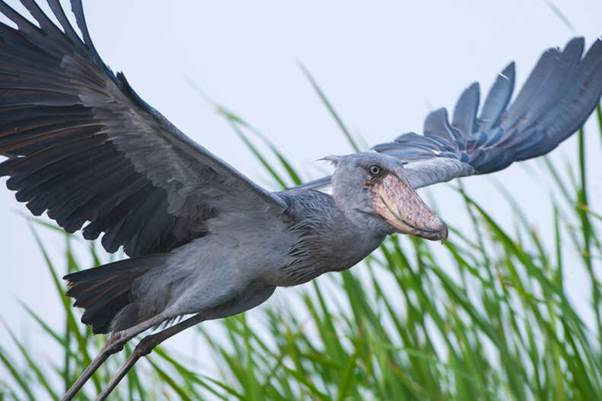
Community Conservation and Ecotourism
Fortunately, local communities near shoebill habitats are rising to the challenge. Residents in Mambamba Lake and surrounding areas have formed volunteer groups to monitor the swamps and report suspicious activity to authorities. These local conservationists play a vital role in protecting the birds from poachers and maintaining a safe environment for breeding and hunting.
Additionally, ecotourism has become a valuable tool in shoebill conservation. Tourists visiting East Africa can sometimes catch a glimpse of these majestic birds in their natural habitat. Guides lead visitors through dense marshlands, offering a rare chance to observe shoebills hunting and interacting in the wild. These guided tours not only generate income for local communities but also raise awareness of the species’ plight and the importance of preserving their fragile ecosystems.
Seeing a shoebill in the wild is a breathtaking experience. Standing motionless in the marsh, eyes locked on potential prey, the bird embodies patience and precision. Observers often remark on the surreal quality of watching a creature that looks both ancient and almost mechanical, yet fully alive and aware of its surroundings. For conservationists and bird lovers alike, witnessing a shoebill in its natural environment is a reminder of the incredible biodiversity that still exists and the responsibility humans have to protect it.
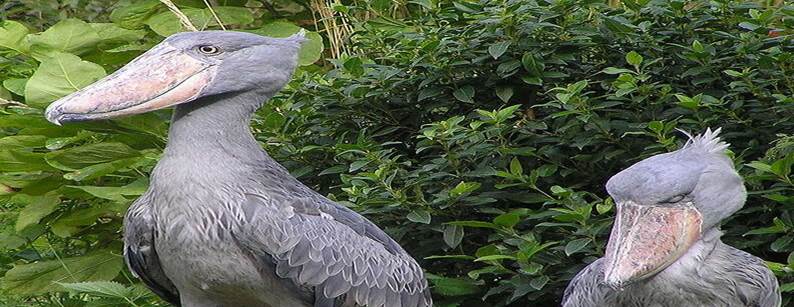
A Living Prehistoric Wonder
Shoebills are more than just unusually large birds — they are living symbols of the complexity and beauty of East Africa’s marsh ecosystems. Their prehistoric appearance, extraordinary hunting skills, and calm yet commanding presence make them one of the most fascinating species on the planet. While threats like habitat destruction and illegal trade pose significant risks, dedicated conservation efforts by locals, researchers, and organizations are giving shoebills a fighting chance.
As these birds continue to glide silently over the marshes and wait patiently for their next meal, they remind us of the resilience of nature. Their existence challenges perceptions, sparks curiosity, and inspires a sense of wonder. In a world where wildlife faces countless pressures, the shoebill stork stands tall — literally and figuratively — as a testament to survival, patience, and the enduring mysteries of the natural world.

